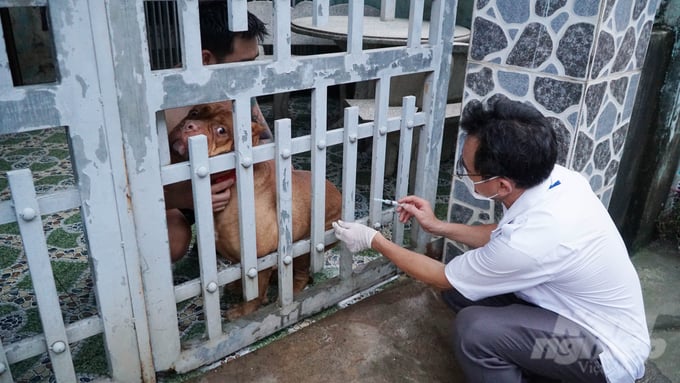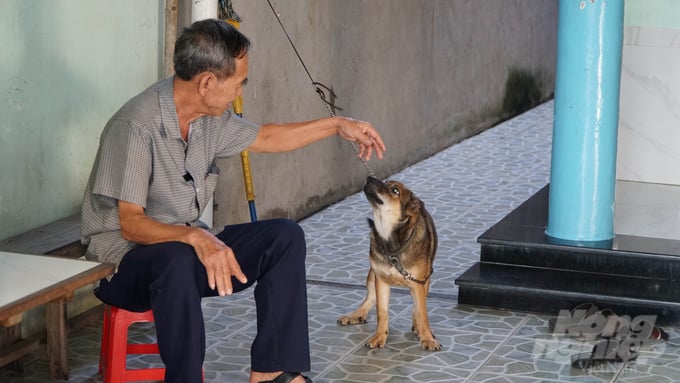November 25, 2025 | 12:23 GMT +7
November 25, 2025 | 12:23 GMT +7
Hotline: 0913.378.918
November 25, 2025 | 12:23 GMT +7
Hotline: 0913.378.918

Veterinary forces of localities in Dong Nai are putting in more effort to "go to every alley, knock on every door" to vaccinate dogs and cats against rabies. Photo: Le Binh.
Since the beginning of the year, Cam My district (Dong Nai) has administered nearly 5,500 doses of rabies vaccine to dogs and cats, but the vaccination rate has only reached 21.7%. Cam My has recorded 670 cases of people bitten or scratched by dogs and cats during this period. The victims had to go to the hospital to receive an anti-rabies serum vaccine.
For many days, Vo Hong Hiep, a veterinary officer in Xuan Que commune, Cam My district, has been increasing the number of rabies vaccinations for dogs and cats for families living deep in remote rice farms. As the area is large and people living in remote areas are not often at home, the vaccination work is not progressing smoothly.
“The locality disseminates information and encourages dog and cat owners to register with the hamlet chief. It would make things easier because veterinary staff can directly come to their homes and perform vaccination. Sometimes we have to go home without being able to vaccinate because the owners are not home, others refuse because they do not agree with the required fee,” said veterinary Vo Hong Hiep.
Bien Hoa city and adjacent districts are also speeding up vaccination for pets. Considering a population of approximately 300,000 dogs and cats, the area’s vaccination rate is only over 40%. This is considered a big hold in the province's attempt to prevent and control rabies.
Than Van Can, Head of the Epidemic Prevention Office, Dong Nai Sub-Department of Livestock Production and Animal Health, believes that there are many reasons why the vaccination rate is still low despite the efforts of veterinary staff.
“Since the end of 2022, the rabies pathogen has reappeared, but because rabies was not recorded in many previous years, the funding source for mass rabies vaccination for dogs and cats ended up facing certain limitations. The funding source used to come from the state budget, but now as socialization is being applied, many people seem hesitant,” he said.
Contrary to common perception, this is not too difficult of a problem. For each rabies vaccine injection, the cost of both the medicine and the veterinary staff is currently VND 50,000. This is not too high a fee, suitable for even low-income households.
“If pets are not vaccinated against rabies, or they bite a person and that person is found to have rabies, the owner may be subject to administrative penalties, or criminal prosecution if the situation is severe,” said Than Trong Can.
Apart from mass-vaccinating pets in the area against rabies, performing rabies vaccination at each and every house also helps Dong Nai Department of Agriculture and Rural Development accurately count the total number of animals. Only when the total number of animals is accurately known can local authorities come up with the most effective measures to prevent and control the epidemic.

Dong Nai strives to limit the number of stray dogs and increase the rabies vaccination rate to over 80%. Photo: Le Binh.
According to Specialist Doctor 1 Phan Van Phuc, Head of the Department of Infectious Disease Prevention, Dong Nai Center for Diseases Control, the low vaccination rate is a “hole” that makes the epidemic more difficult to control. If pets are not protected against the rabies virus, the disease will spread very widely.
“Thanks to conducting epidemiological investigations whenever there is a rabies outbreak, we have found that the rate of dogs and cats vaccinated against rabies is much lower than required. Stray and free-roaming dogs are high in terms of number, making it very difficult to control the disease,” said Phan Van Phuc.
“Dong Nai Sub-Department of Livestock Production and Animal Health has been assigned to coordinate with localities to carry out rabies vaccination campaigns for dogs and cats. The Department of Agriculture and Rural Development has also urgently advised the provincial People's Committee and submitted to the provincial People's Council for approval of the policy of supporting rabies vaccines to organize vaccination for dogs and cats in the province for 5 years, from 2024 to 2028,” said Tran Lam Sinh, Deputy Director of Dong Nai Department of Agriculture and Rural Development.
Translated by Samuel Pham

(VAN) Viettel is applying automation technology that helps Vietnamese agro-products clear customs more quickly, cut costs, and maintain quality.

(VAN) Vinh Long, Viet Nam’s ‘coconut capital,’ is facing a major opportunity to advance sustainable agriculture by reducing carbon emissions from cultivation.

(VAN) Ho Chi Minh City still has many areas for improving forest quality, saving energy, reducing emissions, and generating carbon credits.

(VAN) ILDEX Vietnam 2026 will connect more than 250 exhibitors and 10,000 visitors from 40 countries.

(VAN) Hue City is accelerating efforts to combat IUU fishing, aiming to remove EC’s 'yellow card' and promote sustainable fisheries development.

(VAN) The recent torrential downpours and unprecedented flooding in the Southern Central Coast are a highly unusual meteorological and hydrological event.

(VAN) The Southern Central Coast and Central Highlands regions have suffered massive agricultural losses, with over 80,000 hectares of rice and crops, alongside millions of livestock, being swept away, causing severe damage to farmer livelihoods.